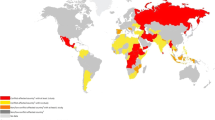Abstract
In the area of child psychosocial intervention research, substantial progress in addressing challenging methodological issues has been made. In this article we suggest that continued movement forward requires maintaining a balance between methodological and theoretical issues, and that it would be advantageous to begin to think about matching advances in methodological sophistication by similar advances in theoretical sophistication. The need to advance our understanding of theoretical issues is especially important in light of the challenges raised by postmodernism, particularly as these challenges relate to knowledge development. We discuss these challenges and describe how a “pragmatic” orientation may be a useful way to respond to them. We also describe how a pragmatic orientation has been useful in our work in developing, implementing and evaluating psychosocial interventions for children with phobic and anxiety disorders.
Similar content being viewed by others
REFERENCES
Barlow, D. H. (1988). Anxiety and its disorders: The nature and treatment of anxiety and panic. New York: Guilford Press.
Chandler, M. J. (1995). Is this the end of “The Age of Development,” or what? Or: Please wait a minute, Mr. Postman. The Genetic Epistemologist, 23, 1–11.
Dewey, J. (1929). Experience and nature. New York: W. W. Norton.
Gadamer, H. G. (1975). Truth and method. London, England: NLB.
Garfield, S. L. (1994). Eclecticism and integration in psychotherapy: Developments and issues. Clinical Psychology: Science and Practice, 1, 123–137.
Gergen, K. J. (1994). Exploring the postmodern: Perils or potentials? American Psychologist, 49, 412–415.
James, W. (1967). Pragmatism: A new name for some old ways of thinking. In J. J. McDermott (Ed.), The writings of William James. New York: The Modern Library. (Original work published 1907)
Habermas, J. (1971). Knowledge and human interest. Boston: Beacon Press.
Kvale, S. (1992). Psychology and postmodernism. London, England: Sage.
Lyotard, J. F. (1984). The post-modem condition: A report on knowledge. Minneapolis: University of Minnesota Press.
Peirce, C. S. (1955). What pragmatism is. In J. Buchler (Ed.), Philosophical writings of Peirce. New York: Dover Publications. (Original work published 1905)
Rorty, R. (1979). Philosophy and the mind as the mirror of nature. Princeton, NJ: Princeton University Press.
Rorty, R. (1992). Consequences of pragmatism: Essays 1972–1980. Minneapolis: University of Minnesota Press.
Silverman, W. K., & Kurtines, W. M. (1996a). Anxiety and phobic disorders: A pragmatic approach. New York: Plenum Press.
Silverman, W. K., & Kurtines, W. M. (1996b). Transfer of control: A psychosocial intervention model for internalizing disorders in youth. In E. D. Hibbs & P. S. Jensen (Eds.), Psychosocial treatment of child and adolescent disorders: Empirically based approaches for clinical practice (pp. 63–82). Washington, DC: American Psychological Association.
Author information
Authors and Affiliations
Rights and permissions
About this article
Cite this article
Silverman, W.K., Kurtines, W.M. Theory in Child Psychosocial Treatment Research: Have It or Had It? A Pragmatic Alternative. J Abnorm Child Psychol 25, 359–366 (1997). https://doi.org/10.1023/A:1025780907141
Issue Date:
DOI: https://doi.org/10.1023/A:1025780907141




